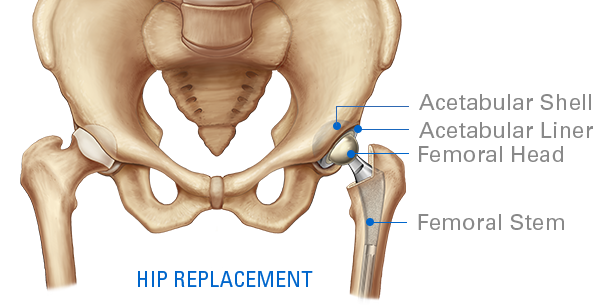
Hip replacement is a surgery recommended for people with severe hip damage. Hip replacement (total hip replacement), is a surgical procedure in which the hip joint is replaced by a prosthetic implant. Replacing the hip joint consists of replacing both the acetabulum and the femoral head. Such joint replacement orthopaedic surgery generally is conducted to relieve arthritis pain or fix severe physical joint damage as part of hip fracture treatment. If your hip has been damaged by arthritis, a fracture or other conditions, common activities such as walking or getting in and out of a chair may be painful and difficult. Your hip may be stiff and it may be hard to put on your shoes and socks. You may even feel uncomfortable while resting.
The normal hip joint is a ball and socket joint. The socket is a "cup-shaped" bone of the pelvis called the acetabulum. The ball is the head of the thigh bone (femur). Total hip joint replacement involves surgical removal of the diseased ball and socket and replacing them with a metal ball and stem inserted into the femur bone and an artificial plastic cup socket. By replacing your diseased hip joint with an artificial joint, hip replacement surgery can relieve your pain, increase motion, and help you get back to enjoying normal, everyday activities. Hip replacement is currently the most successful and reliable orthopaedic operation with 97% of patients reporting improved outcome.
Osteoarthritis of the hip is the most common reason for a hip replacement. Aging causes wear and tear of the cartilage covering the joint surfaces resulting in great pain and stiffness. This condition is called as Osteoarthritis.
Destruction of the hip joint can also be caused due to loss of the blood supply to the head of the thighbone (osteonecrosis), rheumatoid arthritis, injury, infection and developmental abnormalities of the hip. Patients with arthritis may also have brittle bones (osteoporosis), but there is no direct relationship between bone density and the development of arthritis of the hip.
During a traditional hip replacement, which lasts from 1 to 2 hours, the surgeon makes a 6- to 8-inch incision over the side of the hip through the muscles and removes the diseased bone tissue and cartilage from the hip joint, while leaving the healthy parts of the joint intact. Then the surgeon replaces the head of the femur and acetabulum with new, artificial parts. The new hip is made of materials that allow a natural gliding motion of the joint.
In recent years, some surgeons have begun performing what is called a minimally invasive, or mini-incision, hip replacement, which requires smaller incisions and a shorter recovery time than traditional hip replacement. Candidates for this type of surgery are usually age 50 or younger, of normal weight based on body mass index and healthier than candidates for traditional surgery. Joint resurfacing is also being used